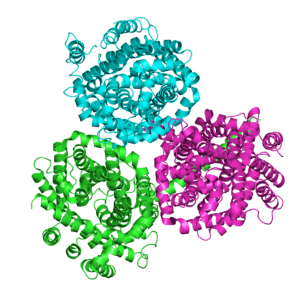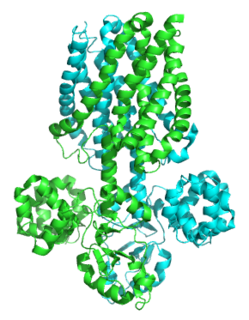Related Research Articles
The vesicular monoamine transporter (VMAT) is a transport protein integrated into the membrane of synaptic vesicles of presynaptic neurons. It acts to transport monoamine neurotransmitters – such as dopamine, serotonin, norepinephrine, epinephrine, and histamine – into the vesicles, which release the neurotransmitters into synapses as chemical messages to postsynaptic neurons. VMATs utilize a proton gradient generated by V-ATPases in vesicle membranes to power monoamine import.

The ATP-binding cassette transporters are a transport system superfamily that is one of the largest and possibly one of the oldest gene families. It is represented in all extant phyla, from prokaryotes to humans.

Glucose transporters are a wide group of membrane proteins that facilitate the transport of glucose across the plasma membrane, a process known as facilitated diffusion. Because glucose is a vital source of energy for all life, these transporters are present in all phyla. The GLUT or SLC2A family are a protein family that is found in most mammalian cells. 14 GLUTS are encoded by human genome. GLUT is a type of uniporter transporter protein.
Translocase is a general term for a protein that assists in moving another molecule, usually across a cell membrane. These enzymes catalyze the movement of ions or molecules across membranes or their separation within membranes. The reaction is designated as a transfer from “side 1” to “side 2” because the designations “in” and “out”, which had previously been used, can be ambiguous. Translocases are the most common secretion system in Gram positive bacteria.

Peptide transporter 1 also known as solute carrier family 15 member 1 (SLC15A1) is a protein that in humans is encoded by SLC15A1 gene. PepT 1 is a solute carrier for oligopeptides. It functions in renal oligopeptide reabsorption and in the intestines in a proton dependent way, hence acting like a cotransporter.
In enzymology, an oligopeptide-transporting ATPase (EC 3.6.3.23) is an enzyme that catalyzes the chemical reaction
A neurotransmitter sodium symporter (NSS) (TC# 2.A.22) is type of neurotransmitter transporter that catalyzes the uptake of a variety of neurotransmitters, amino acids, osmolytes and related nitrogenous substances by a solute:Na+ symport mechanism. The NSS family is a member of the APC superfamily. Its constituents have been found in bacteria, archaea and eukaryotes.

The major facilitator superfamily (MFS) is a superfamily of membrane transport proteins that facilitate movement of small solutes across cell membranes in response to chemiosmotic gradients.

Solute carrier family 15, member 2, also known as SLC15A2, is a human gene.

Proteins of the Betaine/Carnitine/Choline Transporter (BCCT) family are found in Gram-negative and Gram-positive bacteria and archaea. The BCCT family is a member a large group of secondary transporters, the APC superfamily. Their common functional feature is that they all transport molecules with a quaternary ammonium group [R-N (CH3)3]. The BCCT family proteins vary in length between 481 and 706 amino acyl residues and possess 12 putative transmembrane α-helical spanners (TMSs). The x-ray structures reveal two 5 TMS repeats with the total number of TMSs being 10. These porters catalyze bidirectional uniport or are energized by pmf-driven or smf-driven proton or sodium ion symport, respectively, or else by substrate:substrate antiport. Some of these permeases exhibit osmosensory and osmoregulatory properties inherent to their polypeptide chains.
The Nucleobase:Cation Symporter-1 (NCS1) Family (TC# 2.A.39) consists of over 1000 currently sequenced proteins derived from Gram-negative and Gram-positive bacteria, archaea, fungi and plants. These proteins function as transporters for nucleobases including purines and pyrimidines. Members of this family possess twelve transmembrane α-helical spanners (TMSs). At least some of them have been shown to function in uptake by substrate:H+ symport mechanism.

Members of the Solute:Sodium Symporter (SSS) Family (TC# 2.A.21) catalyze solute:Na+ symport. The SSS family is within the APC Superfamily. The solutes transported may be sugars, amino acids, organo cations such as choline, nucleosides, inositols, vitamins, urea or anions, depending on the system. Members of the SSS family have been identified in bacteria, archaea and eukaryotes. Almost all functionally well-characterized members normally catalyze solute uptake via Na+ symport.

Magnesium transporters E (MgtE) are a family of transmembrane eubacterial MgtE magnesium transporters. Related regions are found also in archaeal and eukaryotic proteins. They have sizes that vary considerably from 311 residues for the Methanococcus thermoautotrophicum protein, 463 residues for a Synechocystis homologue, and 513 residues for the human homologue, SLC41A1. These proteins are capable of transporting Mg2+ and Co2+ but not Ni2+. Multiple alignments contain two highly conserved aspartates that may be involved in cation binding.
Proteins currently known to belong to the Ni2+-Co2+ Transporter (NiCoT) family (TC# 2.A.52) can be found in organisms ranging from Gram-negative and Gram-positive bacteria to archaea and some eukaryotes. Members of this family catalyze uptake of Ni2+ and/or Co2+ in a proton motive force-dependent process.
The amino acid-polyamine-organocation (APC) superfamily is the second largest superfamily of secondary carrier proteins currently known, and it contain several Solute carriers. Originally, the APC superfamily consisted of subfamilies under the transporter classification number 2.A.3. This superfamily has since been expanded to include eighteen different families.
The cation-chloride cotransporter (CCC) family is part of the APC superfamily of secondary carriers. Members of the CCC family are found in animals, plants, fungi and bacteria. Most characterized CCC family proteins are from higher eukaryotes, but one has been partially characterized from Nicotiana tabacum, and homologous ORFs have been sequenced from Caenorhabditis elegans (worm), Saccharomyces cerevisiae (yeast) and Synechococcus sp.. The latter proteins are of unknown function. These proteins show sequence similarity to members of the APC family. CCC family proteins are usually large, and possess 12 putative transmembrane spanners (TMSs) flanked by large N-terminal and C-terminal hydrophilic domains.
The anion exchanger family is a member of the large APC superfamily of secondary carriers. Members of the AE family are generally responsible for the transport of anions across cellular barriers, although their functions may vary. All of them exchange bicarbonate. Characterized protein members of the AE family are found in plants, animals, insects and yeast. Uncharacterized AE homologues may be present in bacteria. Animal AE proteins consist of homodimeric complexes of integral membrane proteins that vary in size from about 900 amino acyl residues to about 1250 residues. Their N-terminal hydrophilic domains may interact with cytoskeletal proteins and therefore play a cell structural role. Some of the currently characterized members of the AE family can be found in the Transporter Classification Database.
The sulfate permease (SulP) family is a member of the large APC superfamily of secondary carriers. The SulP family is a large and ubiquitous family of proteins derived from archaea, bacteria, fungi, plants and animals. Many organisms including Bacillus subtilis, Synechocystis sp, Saccharomyces cerevisiae, Arabidopsis thaliana and Caenorhabditis elegans possess multiple SulP family paralogues. Many of these proteins are functionally characterized, and most are inorganic anion uptake transporters or anion:anion exchange transporters. Some transport their substrate(s) with high affinities, while others transport it or them with relatively low affinities. Others may catalyze SO2−
4:HCO−
3 exchange, or more generally, anion:anion antiport. For example, the mouse homologue, SLC26A6, can transport sulfate, formate, oxalate, chloride and bicarbonate, exchanging any one of these anions for another. A cyanobacterial homologue can transport nitrate. Some members can function as channels. SLC26A3 and SLC26A6 can function as carriers or channels, depending on the transported anion. In these porters, mutating a glutamate, also involved in transport in the CIC family, created a channel out of the carrier. It also changed the stoichiometry from 2Cl−/HCO−
3 to 1Cl−/HCO−
3.

Natural resistance-associated macrophage proteins (Nramps), also known as metal ion (Mn2+-iron) transporters (TC# 2.A.55), are a family of metal transport proteins found throughout all domains of life. Taking on an eleven-helix LeuT fold, the Nramp family is a member of the large APC Superfamily of secondary carriers. They transport a variety of transition metals such as manganese, cadmium, and manganese using an alternating access mechanism characteristic of secondary transporters.
The inorganic phosphate transporter (PiT) family is a group of carrier proteins derived from Gram-negative and Gram-positive bacteria, archaea, and eukaryotes.
References
- ↑ Naider F, Becker JM, Steiner HY (1995). "The PTR family: a new group of peptide transporters". Mol. Microbiol. 16 (5): 825–834. doi: 10.1111/j.1365-2958.1995.tb02310.x . PMID 7476181. S2CID 46360416.
- ↑ Skurray RA, Paulsen IT (1994). "The POT family of transport proteins". Trends Biochem. Sci. 19 (10): 404. doi:10.1016/0968-0004(94)90087-6. PMID 7817396.
- ↑ Bucking, Carol; Schulte, Patricia M. (2012-04-01). "Environmental and nutritional regulation of expression and function of two peptide transporter (PepT1) isoforms in a euryhaline teleost". Comparative Biochemistry and Physiology. Part A, Molecular & Integrative Physiology. 161 (4): 379–387. doi:10.1016/j.cbpa.2011.12.008. ISSN 1531-4332. PMID 22227314.
- ↑ Chen, Xing-Zhen (29 Jan 1999). "Stoichiometry and kinetics of the high-affinity H+-coupled peptide transporter PepT2". Journal of Biological Chemistry. 274 (5): 2773–2779. doi: 10.1074/jbc.274.5.2773 . PMID 9915809.
- ↑ Doki, Shintaro; Kato, Hideaki E.; Solcan, Nicolae; Iwaki, Masayo; Koyama, Michio; Hattori, Motoyuki; Iwase, Norihiko; Tsukazaki, Tomoya; Sugita, Yuji (2013-07-09). "Structural basis for dynamic mechanism of proton-coupled symport by the peptide transporter POT". Proceedings of the National Academy of Sciences of the United States of America. 110 (28): 11343–11348. Bibcode:2013PNAS..11011343D. doi:10.1073/pnas.1301079110. ISSN 1091-6490. PMC 3710879 . PMID 23798427.
As of this edit, this article uses content from "2.A.17 The Proton-dependent Oligopeptide Transporter (POT/PTR) Family" , which is licensed in a way that permits reuse under the Creative Commons Attribution-ShareAlike 3.0 Unported License, but not under the GFDL. All relevant terms must be followed.
| This membrane protein–related article is a stub. You can help Wikipedia by expanding it. |